There’s nothing more satisfying than dropping an original monster on an unsuspecting group of players. While trolls, beholders, mind flayers, and ancient red dragons are great, those monsters have been around for decades. Players know what to expect when encountering them. Veteran players quake when a new monster hits the table, because a fresh creation brings an extra element of terror on top of claws and jaws: fear of the unknown.
I’m here to help you bring that fear to your players. Building new creature from scratch is a complicated task. That’s why I’m going to walk you through the process of monster design step-by-step.
Before You Start, Ask the Important Questions
Before you begin to design any new element of the game, don’t forget to ask these three questions, the importance of which are discussed in the first Design Workshop article:
- What do I want to make?
- Does my creation already exist as official D&D content?
- Can I reskin or tweak another creation to suit my needs?
If the monster you’re considering designing doesn’t already exist and can’t be built by tweaking an existing creature, it’s time to design your own.
Designing Monsters
The Dungeon Master’s Guide provides guidelines for monster creation, which are great. I’ll expand on what’s provided and the steps in my process will vary a bit to give an even more in-depth look. All monsters have the following components you need to design:
- Story
- Size, type, and alignment
- Challenge rating
- Ability scores and modifiers
- Armor Class
- Hit points
- Speed
- Saving Throws
- Skills
- Damage resistances, immunities, and vulnerabilities
- Condition immunities
- Senses
- Languages
- Traits
- Actions
- Reactions
- Legendary Actions
- Lair Actions
Building your monster in D&D Beyond makes life easy. The application breaks down a creature’s elements in an easy-to-use form. Select MONSTERS > CREATE from the D&D Beyond homepage and click CREATE FROM SCRATCH to get started filling in the information for your creation.
For this article, I wanted to show you how to create every aspect of a monster and build an expected terror for my players, so I settled on using a legendary ooze I named the blood marmalade as an example.
Step 1. Story
Let your imagination run wild! What makes your creature different from all others. Open with a paragraph that gives a general overview of the monster. This paragraph describes where the monster lives, what the monster looks like, and how they fit into the larger world. Subsequent paragraphs should dive deep into specific story aspects of your monster. Start each new story aspect section with a bold and italic phrase that sums up that detail of your monster, so a DM skimming the passage can say, “Ah yes! I remember that the blood marmalade is an intelligent ooze that devours knowledge!” Each aspect of your monster should include a good story hook that helps GMs work the monster into their stories. In addition, you’ll want to include a little information on your monster’s physiology if they don’t require food, water, or sleep. Here’s what I wrote for the blood marmalade:
Thousands of years ago, a mad drow wizard named Maroc the Rotten became obsessed with creating a new ooze that could reason and carry out orders. His experiments resulted in the former, which meant Maroc never achieved the latter. His creation, a sanguine goop that preferred to take the vague shape of a humanoid, reasoned its way out of captivity and devoured the mage. The first blood marmalade traveled out into the Underdark, seeking more victims before it multiplied.
Devourers of Knowledge. Blood marmalades are intelligent oozes that gain the memories and knowledge of any creature they devour. Their hunger for flesh is only exceeded by their hunger to know more than any other creature in the world. They set elaborate traps for humanoids, particularly wizards, and try to draw sapient creatures into their lairs with tempting offers of treasure and lost tomes. Any intelligent or fleshy organisms near blood marmalades do not last long, but the odd monsters keep mindless oozes as guards.
You Are What You Eat. Blood marmalades can take on the appearance of any humanoid creature they consumed. They use the visage of their former victims as disguises to lure new meals into their homes and travel among the living to enact their plans.
Maroc’s Malevolence. Because all blood marmalades are descended from the original that consumed Maroc the Rotten, all have a touch of the wizard’s malevolence. They delight in torturing their victims (by appearing as loved ones the ooze devoured if possible) before consuming them. Blood marmalades claim agony and fear make their prey more delicious.
Ooze Nature. An ooze does not require sleep.
Your story information goes in the MONSTER CHARACTERISTICS DESCRIPTION box in D&D Beyond.
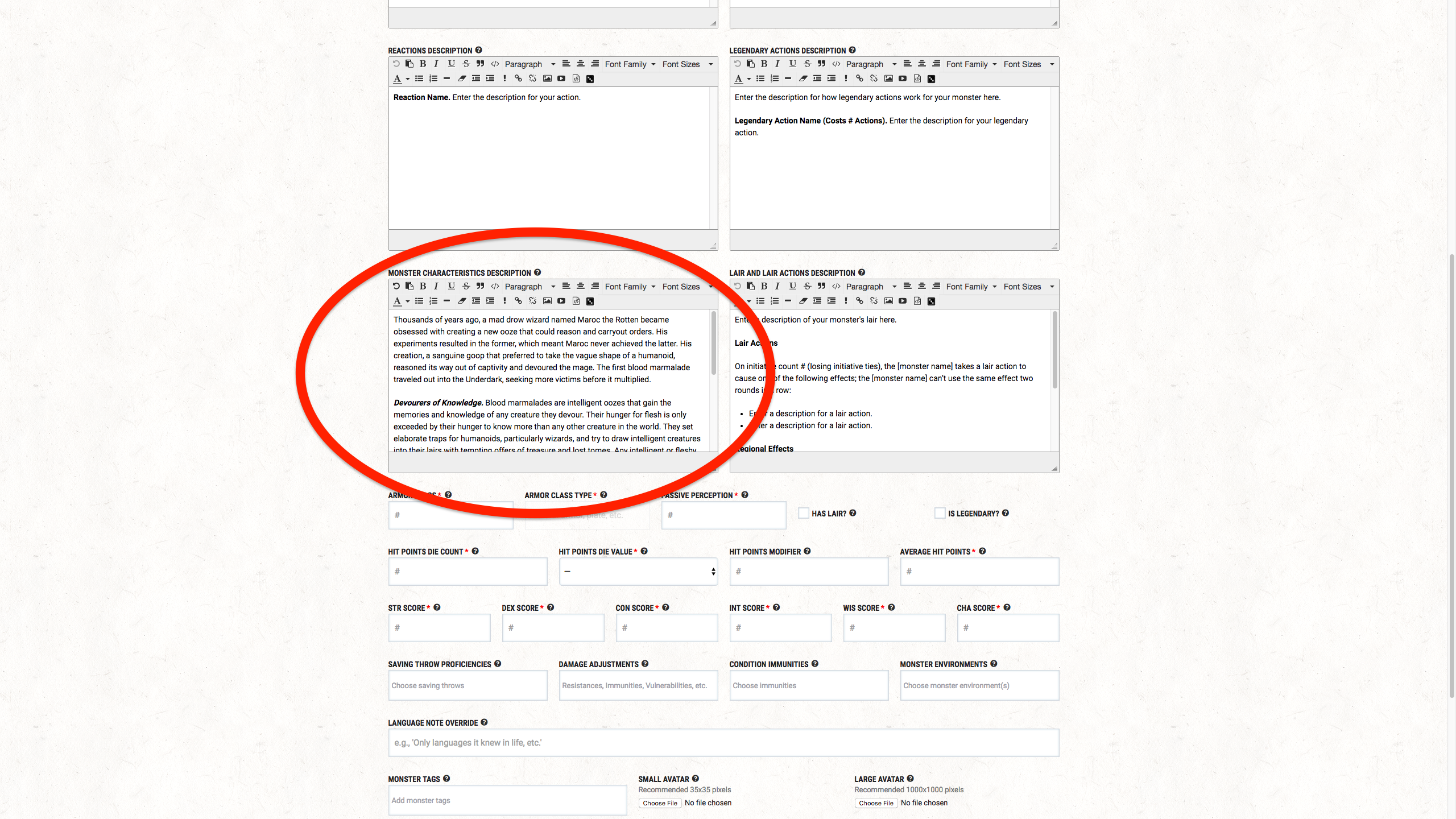
Step 2. Size, Type, and Alignment
How big is your monster? What’s its type? What’s its alignment? Keep in mind a creature’s size affects its hit points (more on that later) and creatures, unlike player characters, can be unaligned. With those caveats, the choices are yours. What makes sense for your creature?
The blood marmalade is a Medium ooze with a chaotic evil alignment.
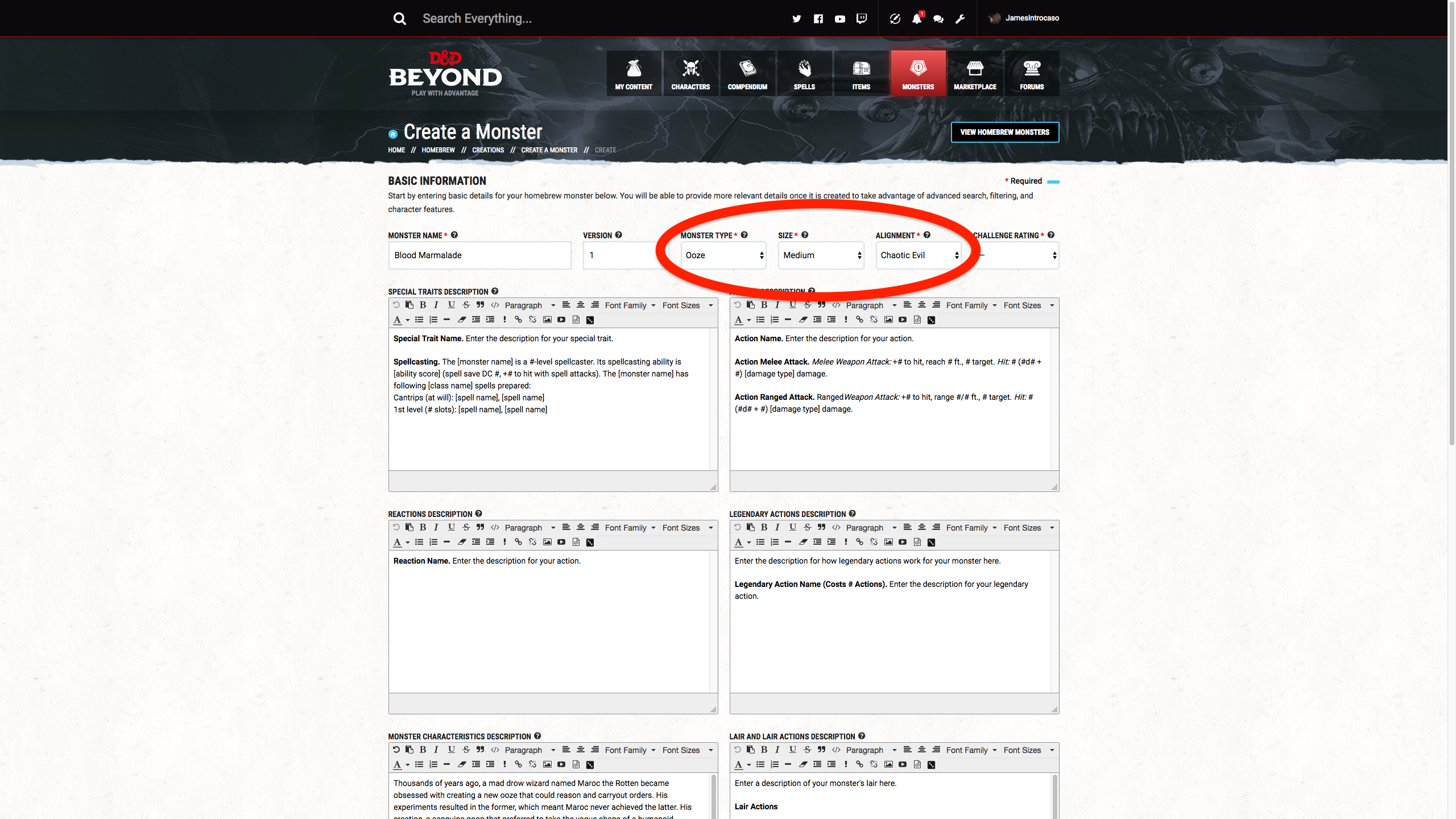
Step 3. Challenge Rating
Before you start getting into the numbers of your monster, you need other monsters to balance it against. Choose the challenge rating you want for your monster first and then design to that challenge rating rather than trying to figure out the number after you’ve designed the rest of the creature. You will be able to compare your beast to other creatures of similar challenge ratings and charts in the Dungeon Master’s Guide if you settle on a challenge rating at the start.
The blood marmalade has a challenge rating of 10 because there aren’t any oozes with a challenge rating that high in the Monster Manual and I want to surprise my players.
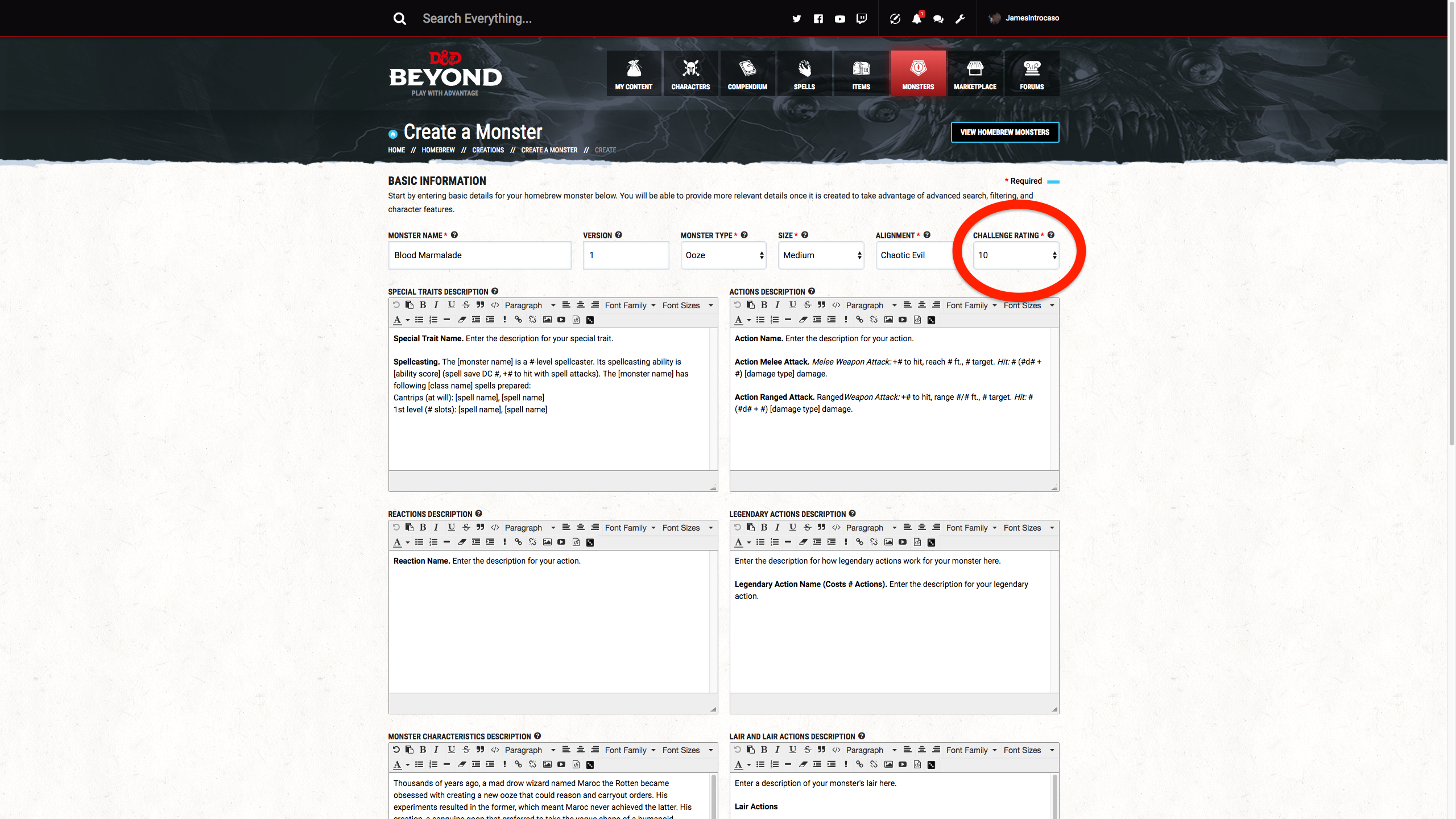
Step 4. Ability Scores and Modifiers
Your monster needs ability scores just like a player character. Remember 10 represents the score of an average human and 20 is the peak of human achievement. Use those as a baseline, and look at other monsters of the same challenge rating, size, and type in the Monster Manual to get an idea of your creature’s statistics. For instance, I want the blood marmalade to be just as strong and tough as gelatinous cube, so I gave it a Strength score of 14 and a Constitution score of 20. The blood marmalade is as smart as a mind flayer, so I gave the creature an Intelligence score of 19. Since my ooze is an outlier when it comes to creatures of the same type, I gave it a higher Dexterity, Wisdom, and Charisma score than other oozes.
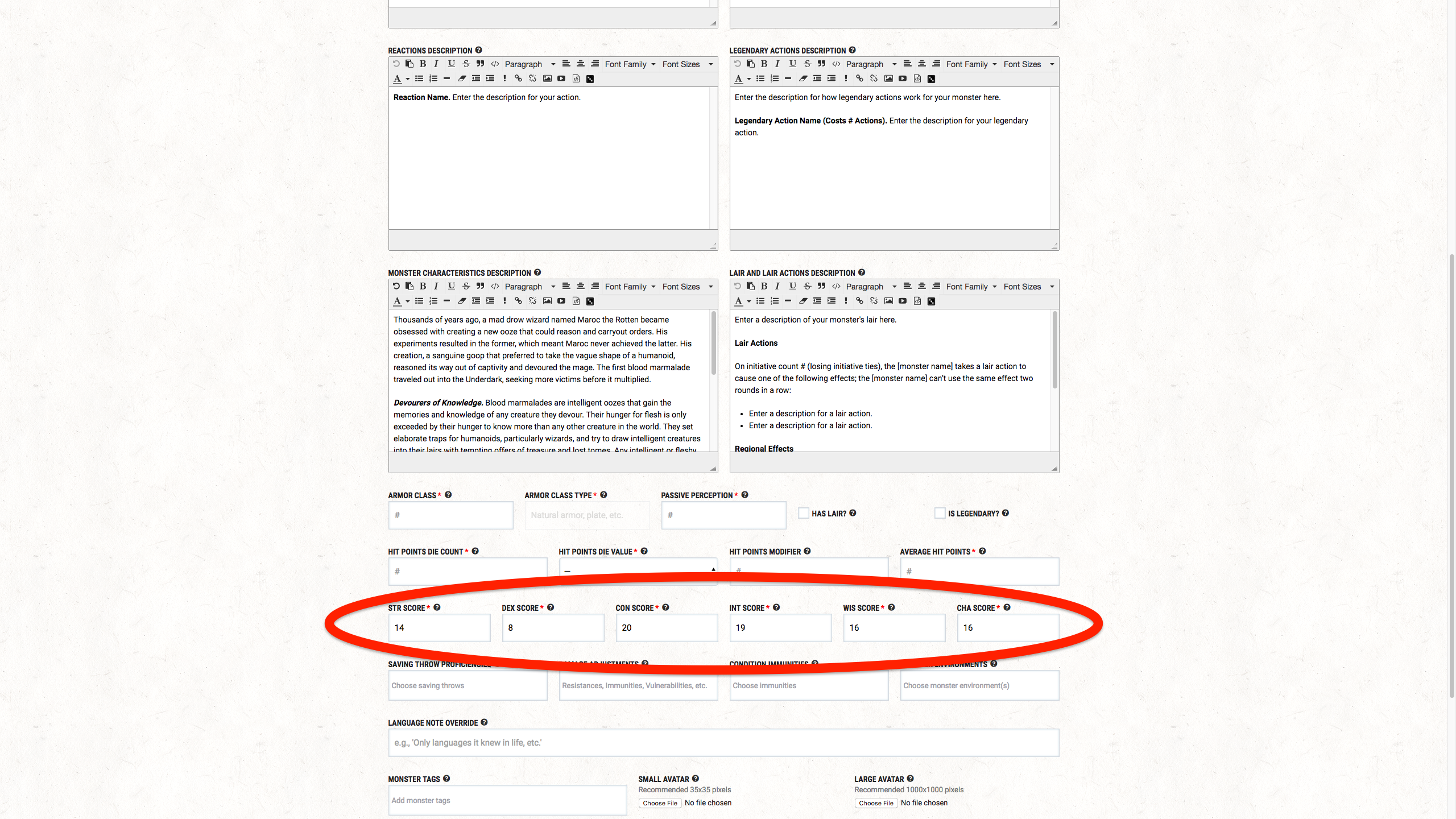
Step 5. Armor Class
A monster’s Armor Class is calculated the same way a player character’s is, by adding 10 to the creature’s Dexterity modifier. Compare this number to other creatures of the same challenge rating and type. You should also refer to the Monster Statistics by Challenge Rating table in chapter 9, “Dungeon Master’s Workshop,” of the Dungeon Master’s Guide. The table is a solid guideline, but not gospel. You can find outliers for all statistics throughout the Monster Manual that don’t come close to the table’s numbers like the demilich, mind flayer, and pixie (all of which have lower hit points for their challenge ratings offset their powerful spellcasting abilities among other strengths).
If you want to increase your creature’s AC, you can add as much to it as you like to make it balanced by giving the creature natural armor or a suit of armor from chapter 5, “Equipment,” in the Player’s Handbook or Basic Rules. If you raise your creature’s AC, keep in mind that the tarrasque and Tiamat, fifth edition D&D’s toughest and most-difficult-to-hit official creatures, still only have an AC of 25. It's more fun to hit monsters than to miss them, so consider improving their defenses by giving them more hit points instead of more AC.
If your creature’s AC is too high, give the creature a lower Dexterity score or leave its AC as is and balance for it being harder to hit by giving it less than average hit points (or another weakness somewhere down the line).
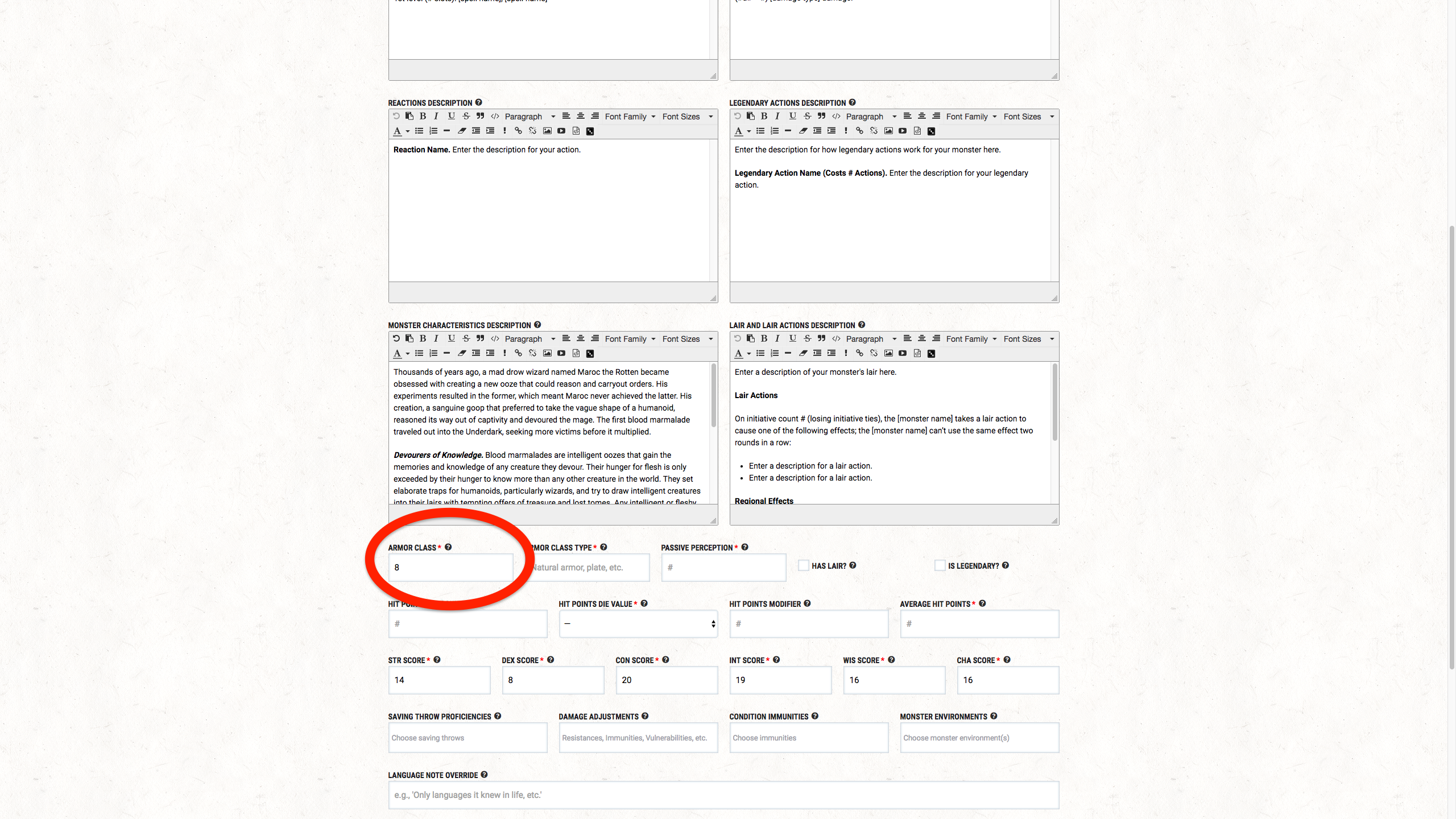
Step 6. Hit Points
For hit points, you’ll want to check the Monster Statistics by Challenge Rating table as well as other monsters of the same challenge rating and type as your original creature as you did with AC. Once you have a good range of hit points, figure out how many Hit Dice your creature needs to get to your desired total. As the Dungeon Master’s Guide points out, creature Hit Dice are based on size. To figure out a creature’s hit point total, use this equation: hit points = Y x (Hit Dice average + Constitution modifier). Y equals the number of Hit Dice used.
For the blood marmalade, I looked at many other CR 10 creatures using the monster filters in D&D Beyond. White Maw (an ooze) from Dead in Thay in Tales from the Yawning Portal had the most hit points at 217 and Madam Eva from Curse of Strahd has the fewest hit points at 88. Most of the monsters from other sourcebooks fell between 135 and 184 hit points (fewer than what the Monster Statistics by Challenge Rating table recommends). I want the blood marmalade to be a bit tougher than average because of its low AC. I first figured out its Hit Die size, which is d8 given its Medium size. The average of a d8 is 4.5 and the blood marmalade’s Constitution modifier is +5, so the blood marmalade gets 9.5 hit points for every Hit Die it has. If I give the ooze 20 Hit Dice, that brings its total to 190, which seems perfect. Its hit points are expressed as 190 (20d8 + 100).
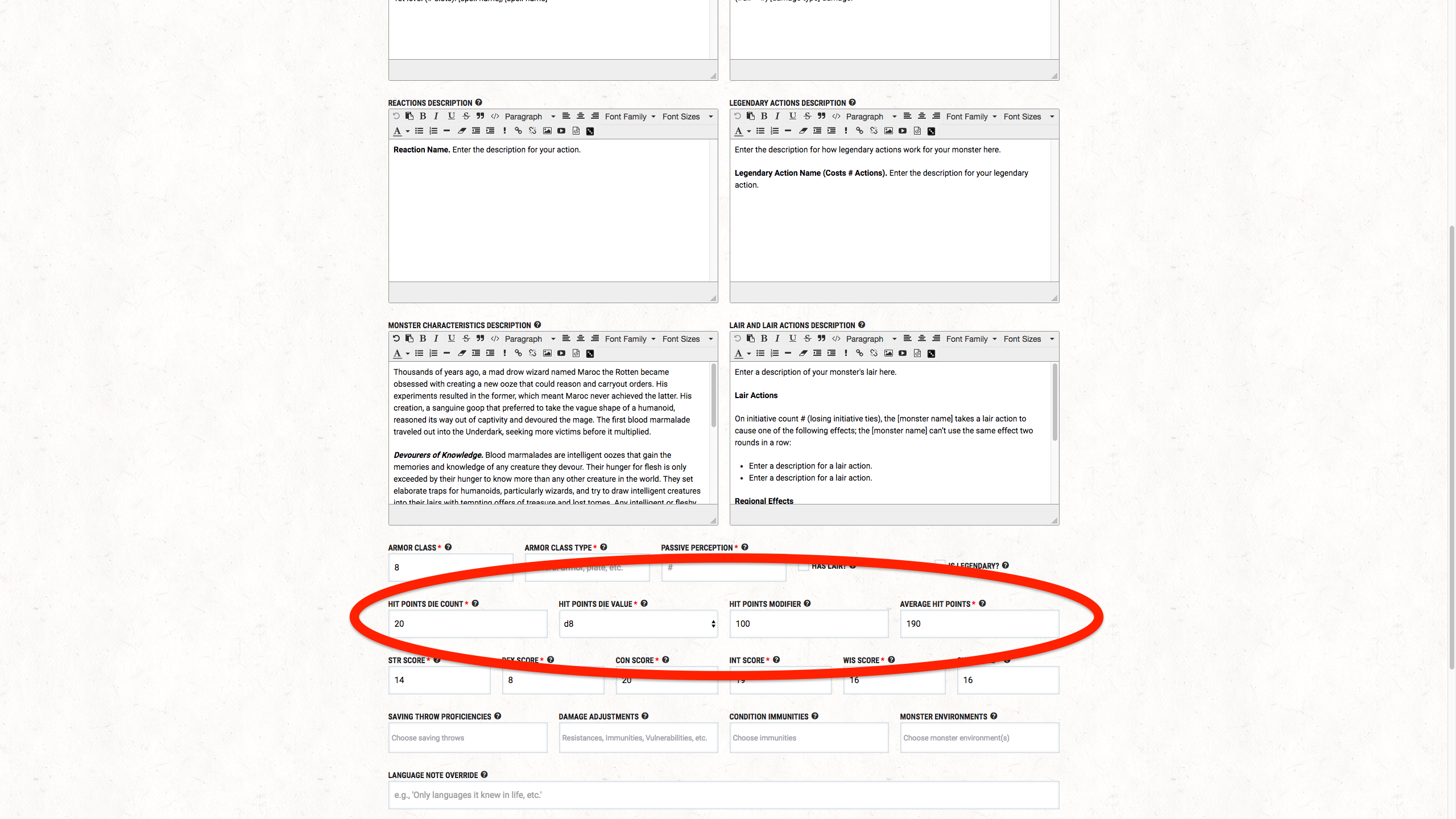
Step 7. Speed
Compare your monster’s speed to others of its challenge rating, type, and size. Give it any special movements speeds, like climbing, that you want it to have. Some special movement speeds, like burrowing or flying, can affect a creature’s challenge rating at lower levels, but at higher levels, most player characters have powerful enough spells or magic items to make those speeds less of a problem.
Most oozes are slow and can climb. The blood marmalade is a special kind of powerful (there aren’t many official oozes with CR greater than 4), so I’m going to give it a fast-for-an-ooze movement speed of 30 and a climbing speed to match. Speed is added after you create your monster in D&D Beyond (more on that later).
Step 8. Saving Throws
You don’t need to add saving throw proficiencies if it doesn’t seem right for your creature or if the monster already has many powerful ability scores. Leave at least one save weaker than the others to give your creature a little realism and not frustrate your spellcasting players as the creature succeeds on save after save. Even the tarrasque and Tiamat aren’t as good with Dexterity saving throws as they are with others. (Note that the monster’s proficiency bonus is based on its CR and can be found on the Monster Statistics by Challenge Rating table in the Dungeon Master’s Guide.)
The blood marmalade is already set with most of its ability scores, but given the fact that it absorbs memories, I’m going to boost its Wisdom saving throw as a reflection of that.
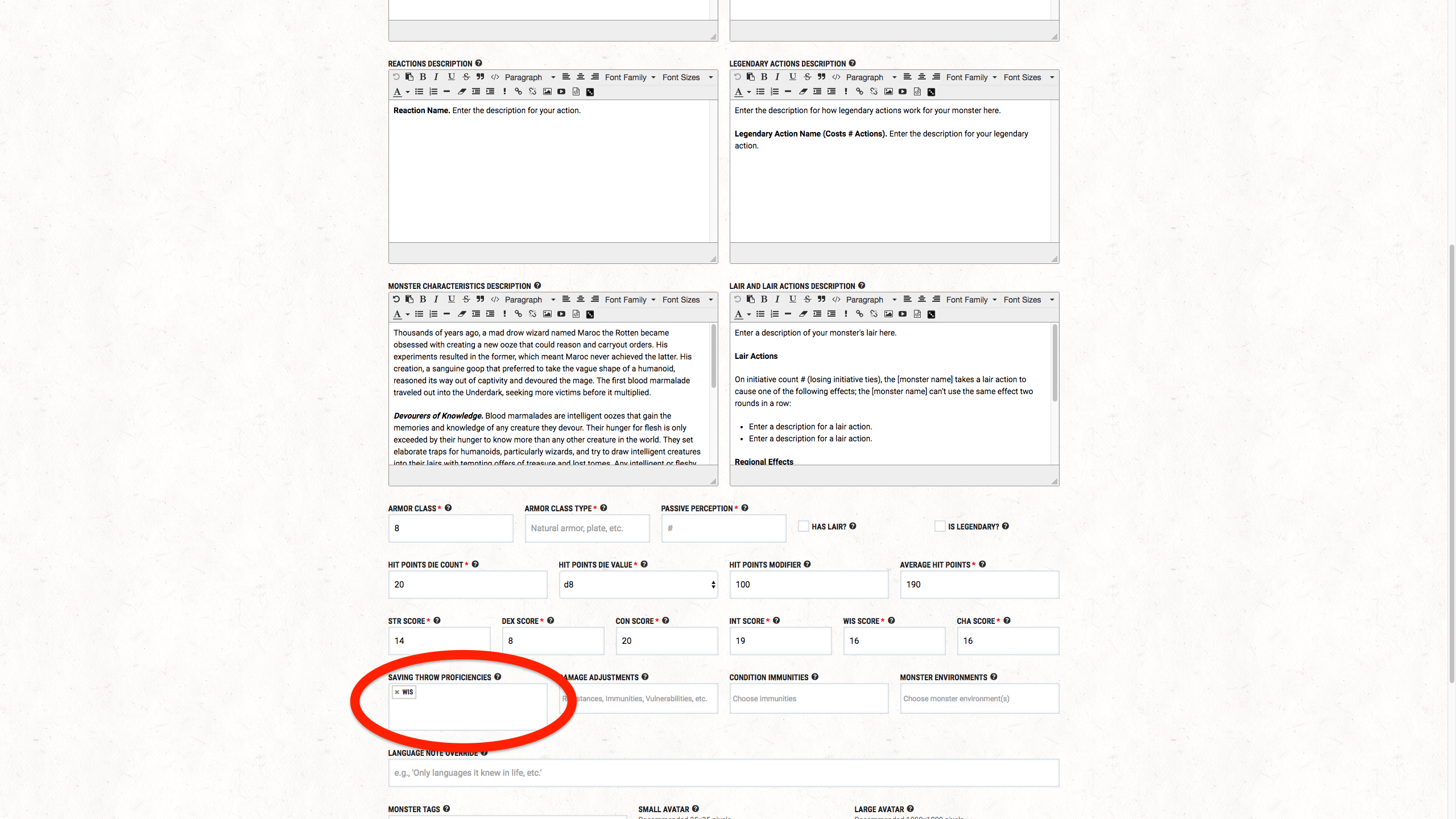
Step 9. Skills
Like saving throws, your monster doesn’t need to be proficient in any skills, only the ones that make sense. Don’t be too worried about balance here. A few skill bonuses don’t make or break a creature, unless they have a feature tied to one of the skills (like Sneak Attack and the Stealth skill) and even then, it’s likely the skill boost is warranted to make the ability work.
For the blood marmalade, I’ve given it proficiency in Deception so it can pretend to be something it's not. Skill proficiencies are added after you create your monster in D&D Beyond (more on that later).
Step 10. Damage Resistances, Immunities, and Vulnerabilities
Your monster does not need any damage resistances, immunities, or vulnerabilities. Do whatever makes sense for the story. To get some ideas, look at other creatures of the same type. One to three resistances or immunities don’t change a monster’s challenge rating, but four or more should make you think twice about adjusting another aspect of the monster (like its hit points) to compensate. The exception to this rule is resistance or immunity from bludgeoning, piercing, and slashing damage from nonmagical weapons. At lower levels such a strength is difficult to overcome no matter what other resistances a creature the creature has, but by a party of level 5 characters can cast a spell or two to overcome the resistance.
Unlike previous editions of D&D, fifth edition D&D uses vulnerabilities quite sparingly. Implement vulnerabilities with restraint, since double damage makes some (or all depending on the party and damage type) player characters twice as strong.
The blood marmalade is a super-strong ooze, and as such, I gave it acid damage immunity.
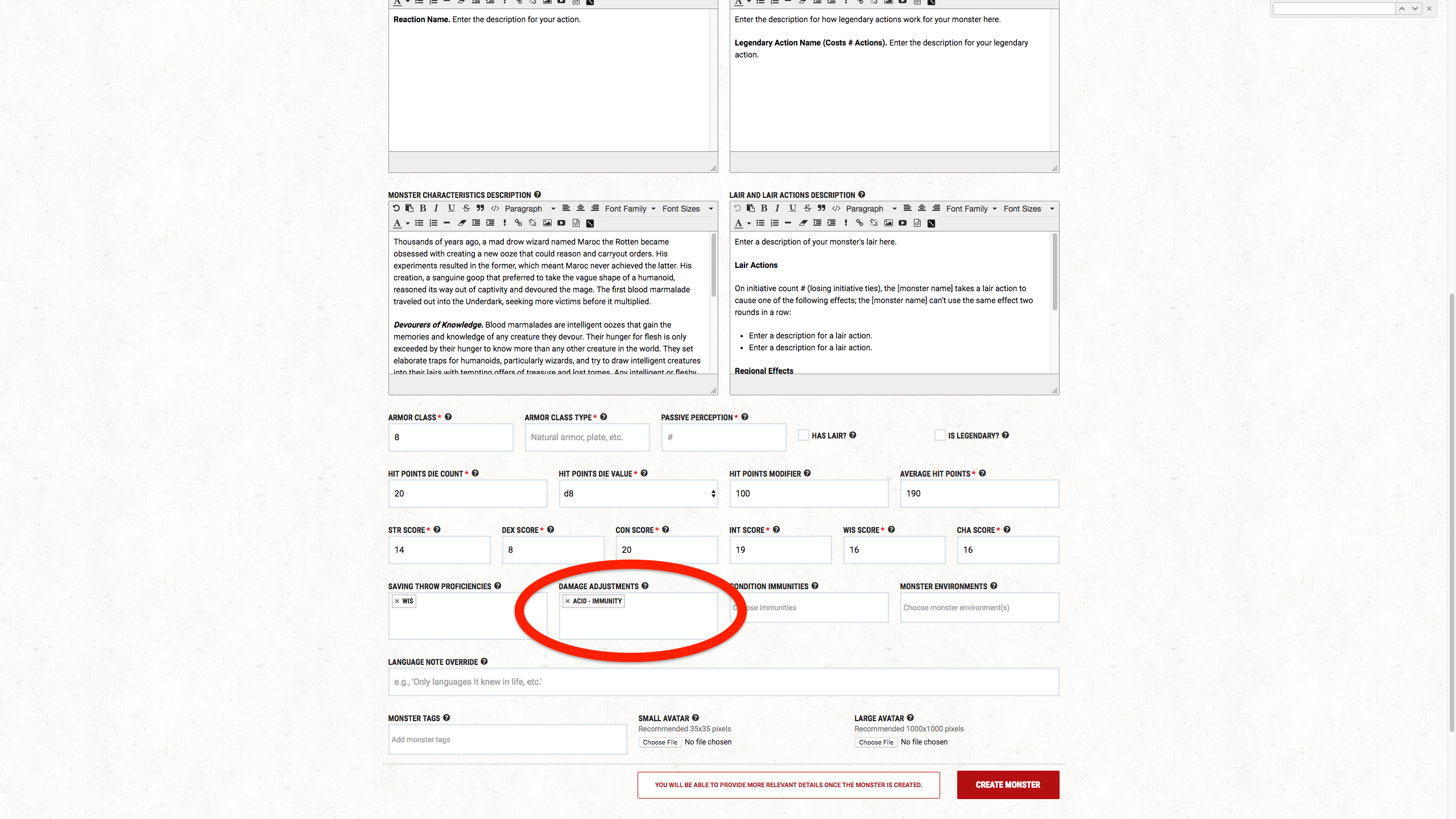
Step 11. Condition Immunities
Your monster does not need condition immunities. Stick to what makes sense and look at other creatures of the same type. Some creature types (like oozes) have many condition immunities because they make sense with the creature’s story. Something that’s formless is never prone, something that’s mindless can’t be charmed or frightened, and something that can’t see or hear (but uses other senses) can’t be blinded or deafened. Those all make sense for an unintelligent ooze. Figure out what conditions should not apply to your creature and only add more condition immunities beyond what makes sense to compensate for the creature lacking in another area, like AC, hit points, etc.
Since the blood marmalade is an intelligent ooze that can see and hear things, it has far fewer condition immunities than other oozes. (Such is the price of sapience.) It is still immune to the prone condition and exhaustion, because it still has the physiology of an ooze.
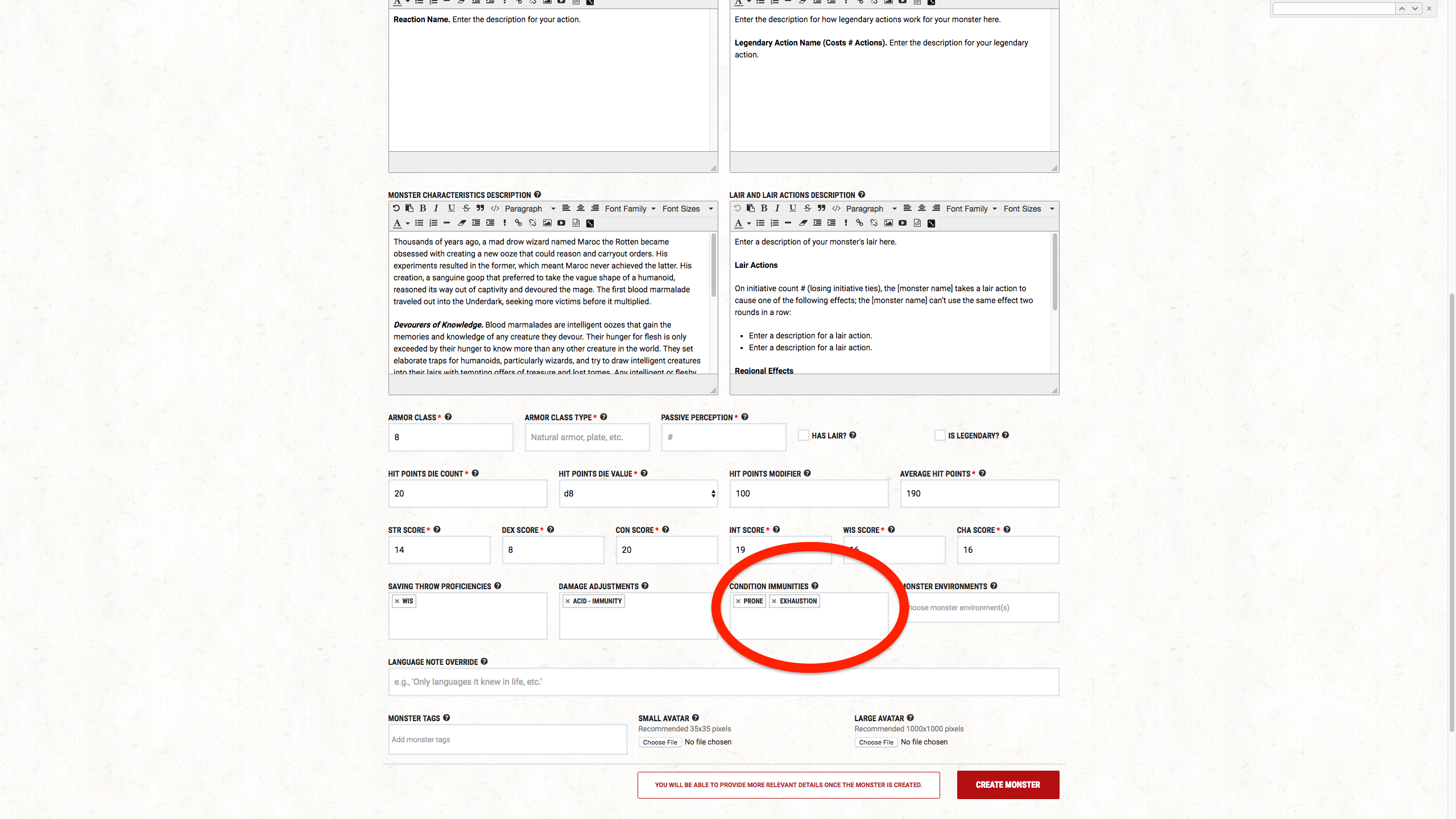
Step 12. Senses
Your creature should at least have a passive Perception score (calculated the same way it is for player characters). If your creature has any extra senses like blindsight or darkvision add them as well. Most senses won’t break the game. Add whatever makes sense for your creature’s story.
Unlike other oozes, the blood marmalade does not have blindsight, but it can see and lives in the Underdark, so I gave it 120-foot darkvision. Special senses are added after you create your monster in D&D Beyond (more on that later), but you can add your creature’s passive Perception score before that.
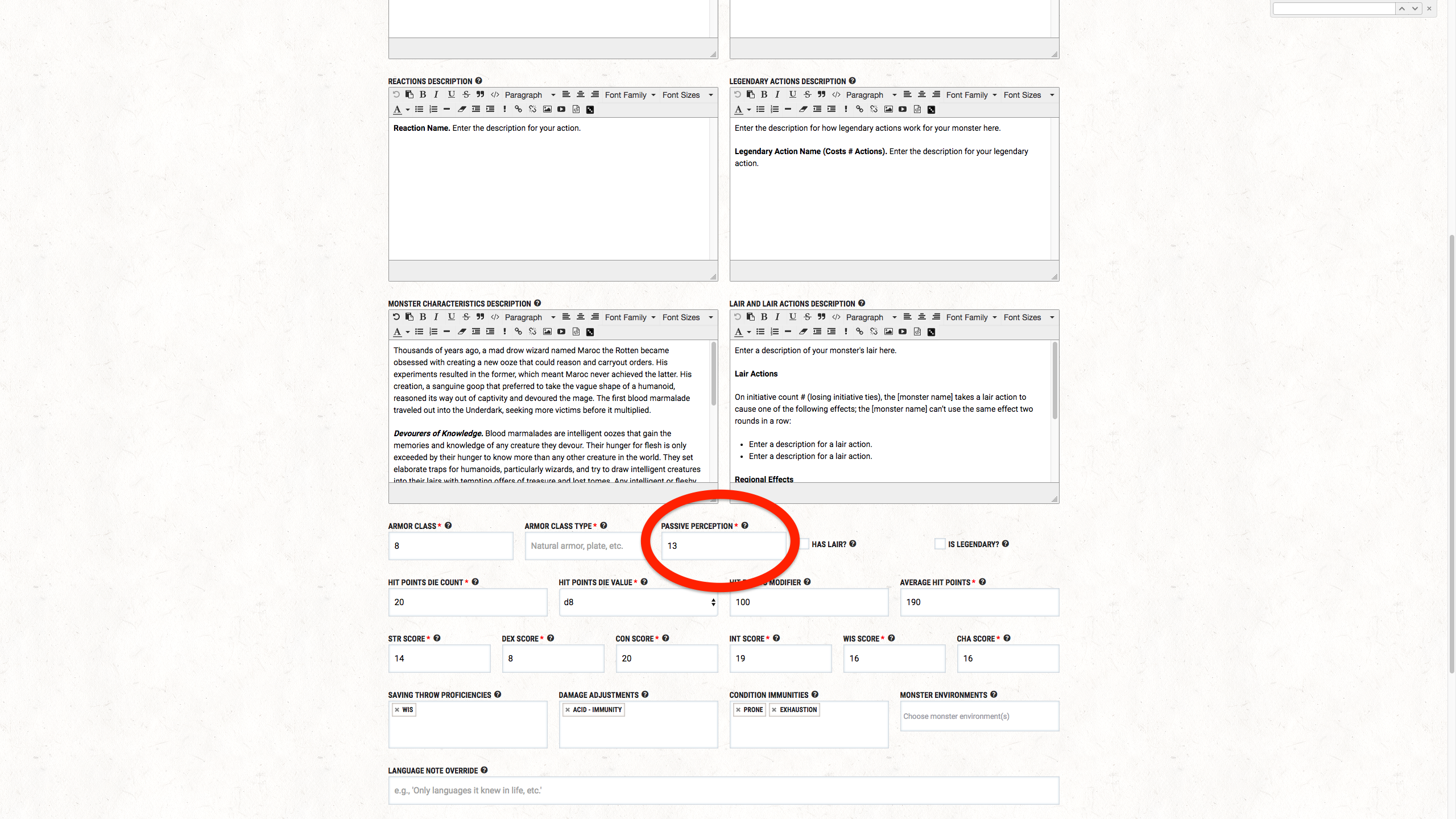
Step 13. Languages
What languages, if any, does your creature read, speak, and understand? You can’t break the game here so add as many or as few languages as you like. Feel free to put any restrictions or story elements into this description. For instance, the blood marmalade speaks “Common, Elvish, Undercommon, and the languages of any creatures it has consumed.”
Languages are added after you create your monster in D&D Beyond (more on that later), but you can add any special notes about languages before that.
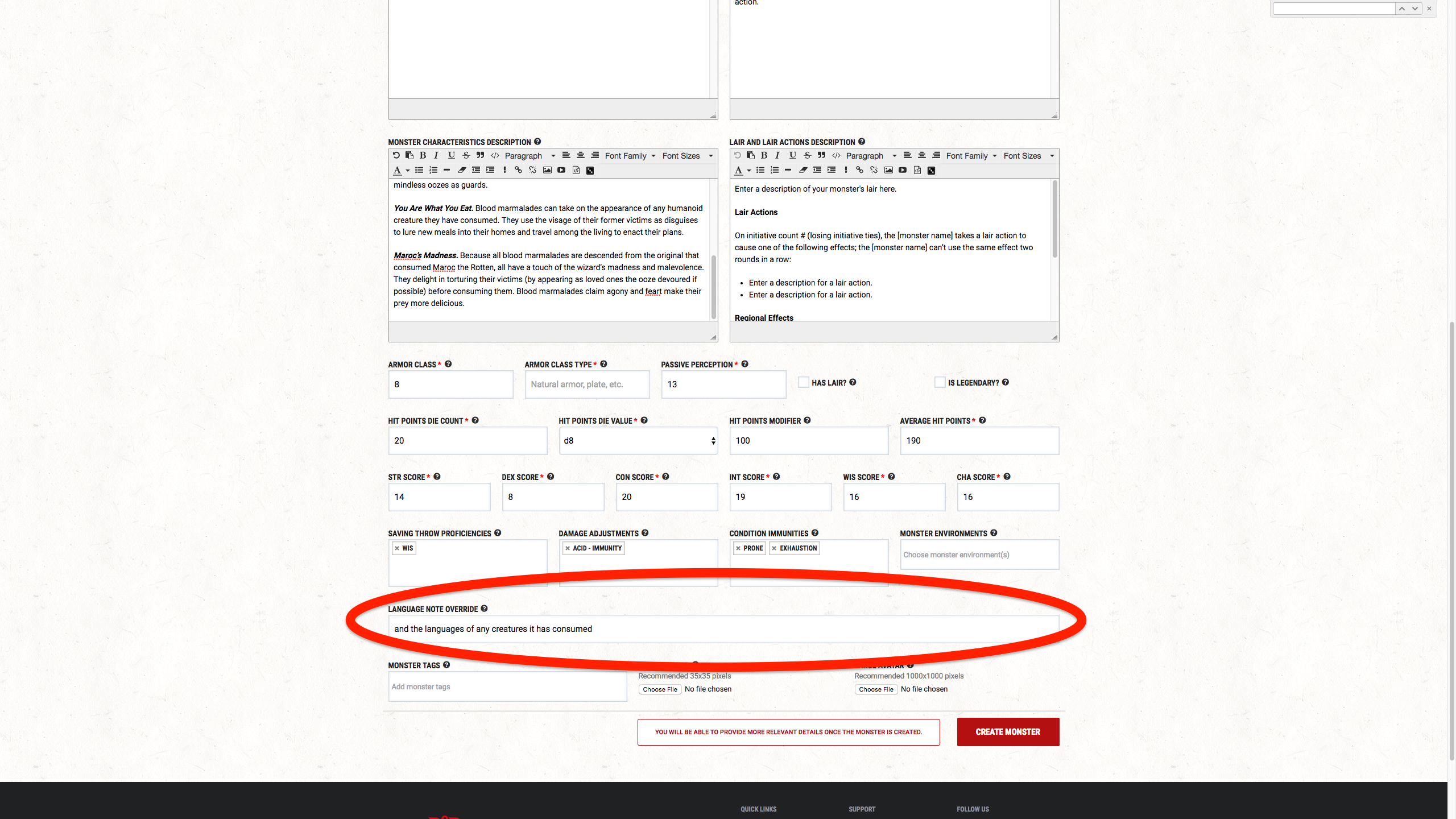
Step 14. Traits
What makes your monster special? Some creatures, like tyrannosaurus rex, have no special traits. Others, like the vampire, have many. From spellcasting to walking on webs, anything special your creature can do that is not an action or reaction should be here.
If you want to use a feature that another monster has, use the same name and just tweak the feature’s wording to apply to your monster. This helps DMs everywhere because when I see the Pack Tactics feature in a stat block, I know what it does without having to read the rest of the description because I’ve seen the feature on other creatures before. That’s what I did for the blood marmalade’s Amorphous feature taken from the ochre jelly and the Legendary Resistance feature taken from the ancient gold dragon.
I did have to create the Knowledge Consumed feature from scratch. Nevertheless, I imitated the language used by other official D&D monster traits to make sure this feature plays nice with other rules in the game:
Knowledge Consumed. When the marmalade kills a creature with its slam attack or when it consumes a corpse that has been dead for less than 24 hours, it gains all of that creature’s memories and learns everything the creature knew, including any languages. If the creature is a Medium or smaller humanoid, the marmalade can also take on that creature’s appearance using Change Shape.
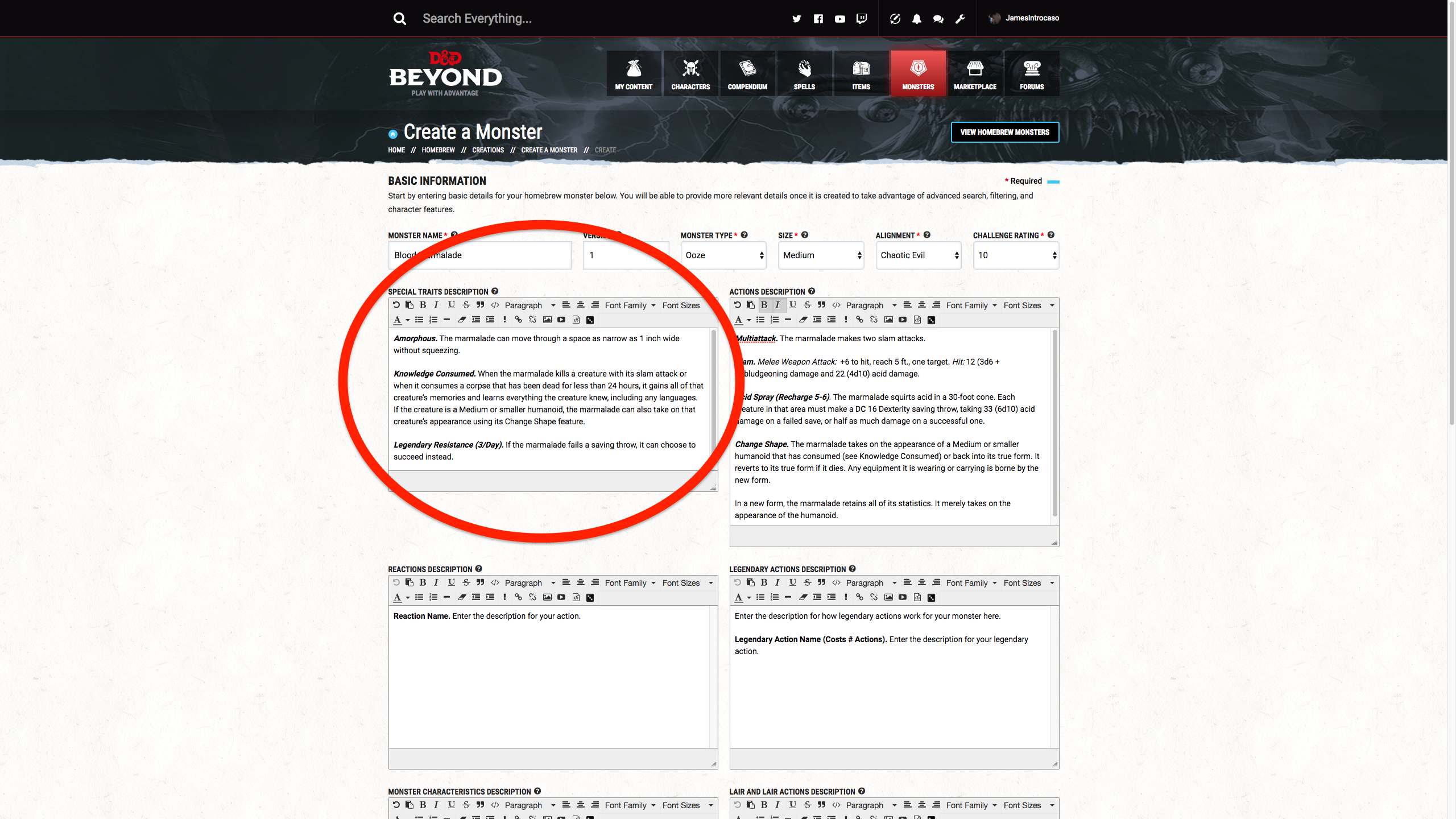
These three features together don’t change the ooze’s power level beyond CR 10, since they don’t increase its raw power much. Legendary Resistance is the blood marmalade’s most powerful mechanical feature and has a limited use.
If you add a lot of features to your creature, consider how they change the creature’s power level. The power to cast spells like a level 14 wizard or a big boost to damage mean you probably should increase your creature’s challenge rating or reduce its hit points, AC, or damage output. There’s a reason wizards don’t have as many hit points as a fighter.
Step 15. Actions
Your creature’s attacks and other actions should go under this heading. List them in this order:
- Multiattack (if the creature has it)
- Melee and ranged attacks in alphabetical order
- Other actions in alphabetical order
The Dungeon Master’s Guide shares how to calculate the exact attack bonuses and DCs for monster actions. Once again, follow the guidelines on the Monster Statistics by Challenge Rating table and look at monsters of a similar challenge rating to get an idea of what a monster’s average damage output should look like. If a monster is able to cast big damage-dealing spells, do extra damage under specific circumstances (like Sneak Attack), or can dish out a lot of non-damaging but debilitating effects (like petrification), consider give it a lower than average damage output for its regular attacks. Use creatures of a similar challenge rating that cast a lot of spells or those that deal out strange effects as your guide for this.
It seems many challenge rating 10 creatures deal between 2 damage (Madam Eva’s dagger) to 60 (the froghemoth’s two tentacles and a bite). Note the damage range is below that of the Monster Statistics by Challenge Rating table, because all challenge rating 10 monsters have some crazy features beyond damage. The blood marmalade is all about that damage from its slam attacks, so those are on the higher end of the spectrum. Then I also gave it a special acid spray action with a recharge (similar to a dragon’s breath weapon), to give it a ranged attack option and make the creature extra terrifying! Here are all of its actions:
Multiattack. The marmalade makes two slam attacks.
Slam. Melee Weapon Attack: +6 to hit, reach 5 ft., one target. Hit: 12 (3d6 + 2) bludgeoning damage and 22 (4d10) acid damage.
Acid Spray (Recharge 5–6). The marmalade squirts acid in a 30-foot cone. Each creature in that area must make a DC 16 Dexterity saving throw, taking 33 (6d10) acid damage on a failed save, or half as much damage on a successful one.
Change Shape. The marmalade takes on the appearance of a Medium or smaller humanoid that has consumed (see Knowledge Consumed) or back into its true form. It reverts to its true form if it dies. Any equipment it is wearing or carrying is borne by the new form.
In a new form, the marmalade retains all of its statistics. It merely takes on the appearance of the humanoid.
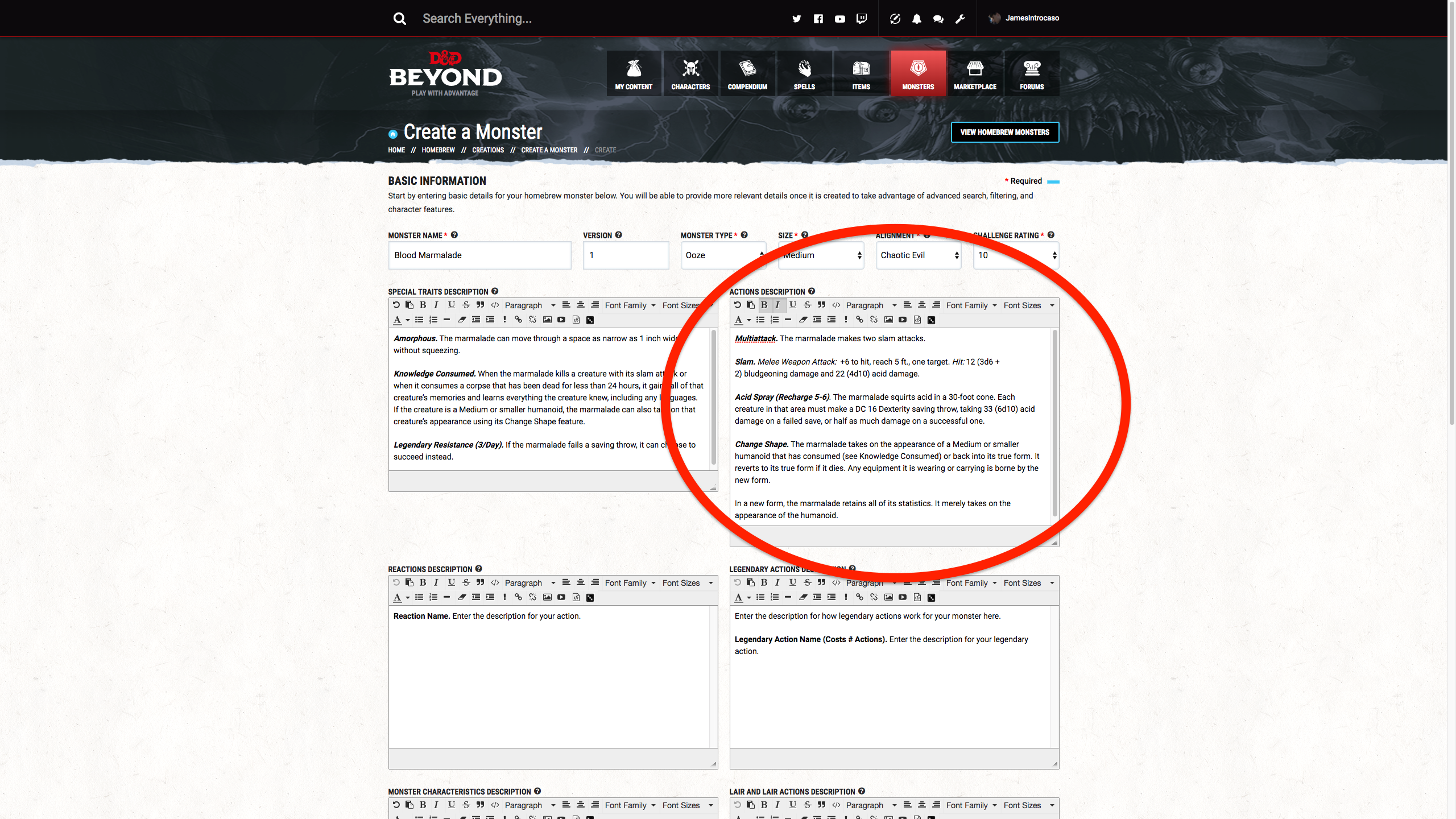
Step 16. Reactions
Does your creature have a special reactions outside of opportunity attacks (like the noble's Parry reaction)? For the most part, reactions should not be as powerful as actions. They’re usually defensive, like providing a quick boost to AC on a hit or a free movement when missed with a melee attack. If a creature’s reaction allows them to do more damage than a normal opportunity attack, there better be a good reason for it and balance somewhere else within the creature.
The blood marmalade has no special reactions for two reasons. First, I want to leave its reactions free to take opportunity attacks with their damaging slam. Second, the ooze also gets legendary actions and adding reactions in on top of everything else is just going to make the creature difficult to run at the table.
Step 17. Legendary Actions
Legendary actions are reserved for D&D’s scariest and most iconic monsters: dragons, beholders, liches, and unicorns to name a few. The blood marmalade joins these ranks!
When you design legendary actions, take a look at other creatures of similar challenge rating’s legendary actions to get an idea of how much damage and the effects these actions have. (D&D Beyond’s search filters make finding these creatures easy.) Like reactions, a single legendary action should not be more powerful than an opportunity attack, but many creatures can spend multiple legendary actions to gain a unique action that’s more powerful. Not all legendary actions need be attacks either, they could be movement-related or grant the creature a skill check, like the aboleth’s Detect.
The blood marmalade’s slam attack is a little too damaging to grant it as a legendary action, but I have some other ideas that I think are well-balanced.
Acid Spit. The marmalade chooses one creature it can see within 20 feet of it. That creature must succeed on a DC 16 Dexterity saving throw or take 16 (3d10) acid damage.
Command Ooze. The marmalade targets one ooze with a challenge rating of 4 or less it can see within 30 feet of it. The ooze can make one weapon attack as a reaction and gains advantage on the attack roll.
Absorb Ooze (Costs 2 Actions). The marmalade targets one ooze with less than 20 hit points remaining within 20 feet of it. The marmalade absorbs the ooze, destroying that creature and regaining a number of hit points equal to the number of remaining hit points the destroyed ooze had.
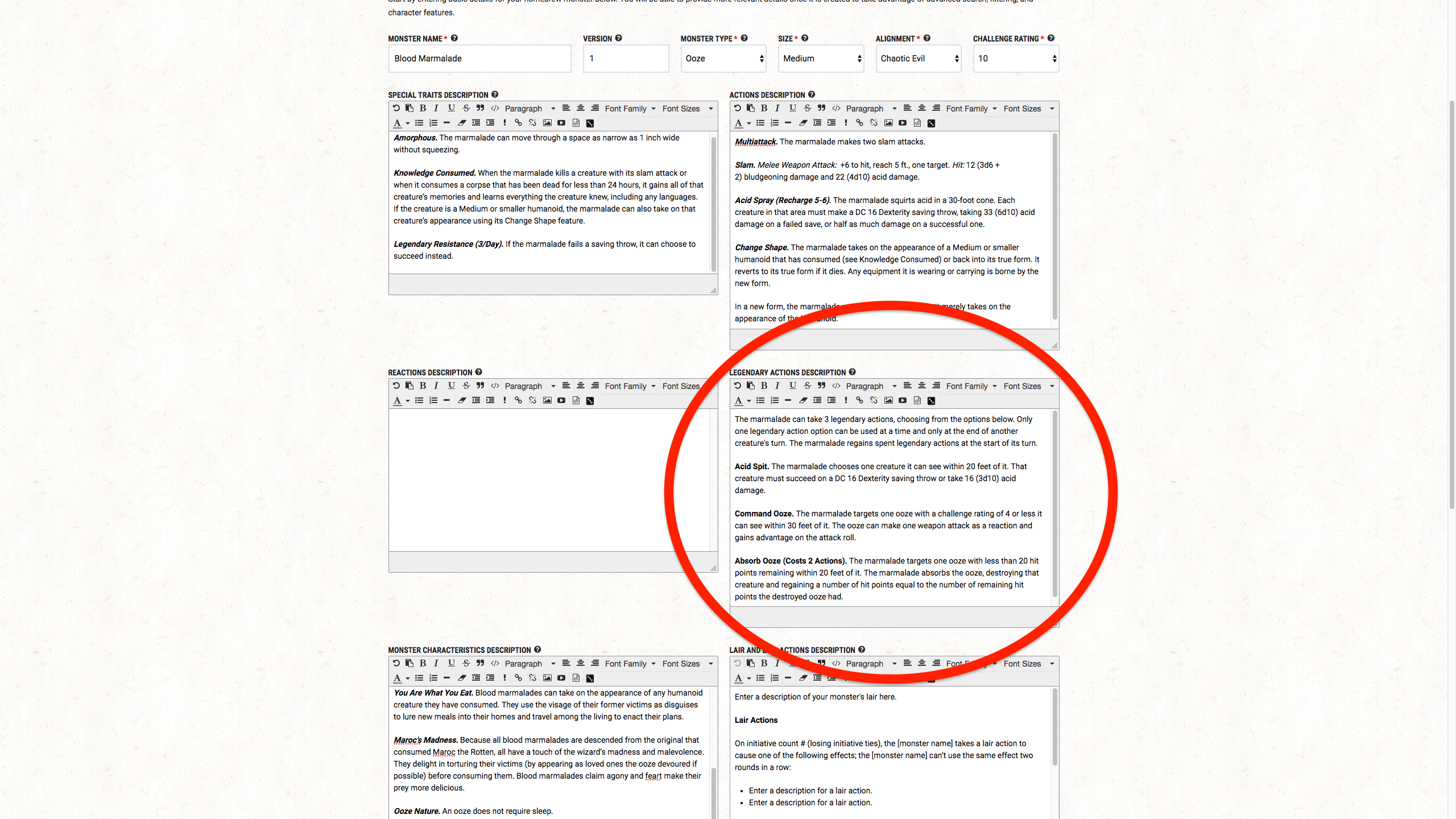
Step 18. Lair Actions
While many creatures have a lair, only a few are powerful enough to have lair actions (these creatures usually also have legendary actions). Include an opening paragraph or three that describes the environment where your creature makes its lair and the defense they have in place.
When it comes time to make lair actions, look at creatures of a similar challenge rating that have them (as you did with legendary actions). Lair actions are no more powerful than an opportunity attack. Use that guideline to help you create two or three lair actions.
Each lair also has at least three regional effects that occur within 1 to 6 miles outside of the creature’s lair. Have fun with these effects! These can be mechanically light and flavorful. If you do give a regional effect a hard mechanic, make sure it doesn’t add to the creature’s power rating and stays regional, like the Ki-rin’s ability to cast control weather.
Here’s the description of the blood marmalade’s lair:
Blood marmalades lair in the towers of wizards they murder and caves in the Underdark. They surround themselves with mindless ooze guardians they can control and make a point of being close enough to a busy road or city so that they can slip out into the night and hunt intelligent prey.
The walls, floors, and ceilings of a blood marmalade's lair drip with a slippery mucus that begins to magically appear in the place after the ooze claims it as a home. The thicker this mucus, the longer the blood marmalade has lived in the lair.
Lair Actions
On initiative count 20 (losing initiative ties), the marmalade takes a lair action to cause one of the following effects; the marmalade can’t use the same effect two rounds in a row:
- A 20-foot-square glob of mucus erupts from the floor within 90 feet of the marmalade. Each non-ooze creature that moves into or is in contact with that area of the floor when the mucus appears must make a DC 15 Dexterity saving throw. Creatures that fail are restrained. The mucus last until initiative count 20 of the next round.
- The marmalade picks one creature it can see within 60 feet of it. A glob of thick mucus magically appear and fly at the creature's head. That creature must succeed on a DC 15 Dexterity saving throw or it is blinded until initiative count 20 of the next round.
Regional Effects
The region containing a legendary marmalade's lair is warped by the ooze's unnatural presence, which creates one or more of the following effects:
- Small lakes of red mud appear within 1 mile of the lair.
- A thick red mist surrounds the area within 1 mile of the lair, making the area lightly obscured.
- Oozes within 3 miles of the lair tremble with excitement and hunt in packs.
If the marmalade dies, any ooze packs immediately disperse and the other effects fade over the course of 3d10 days.
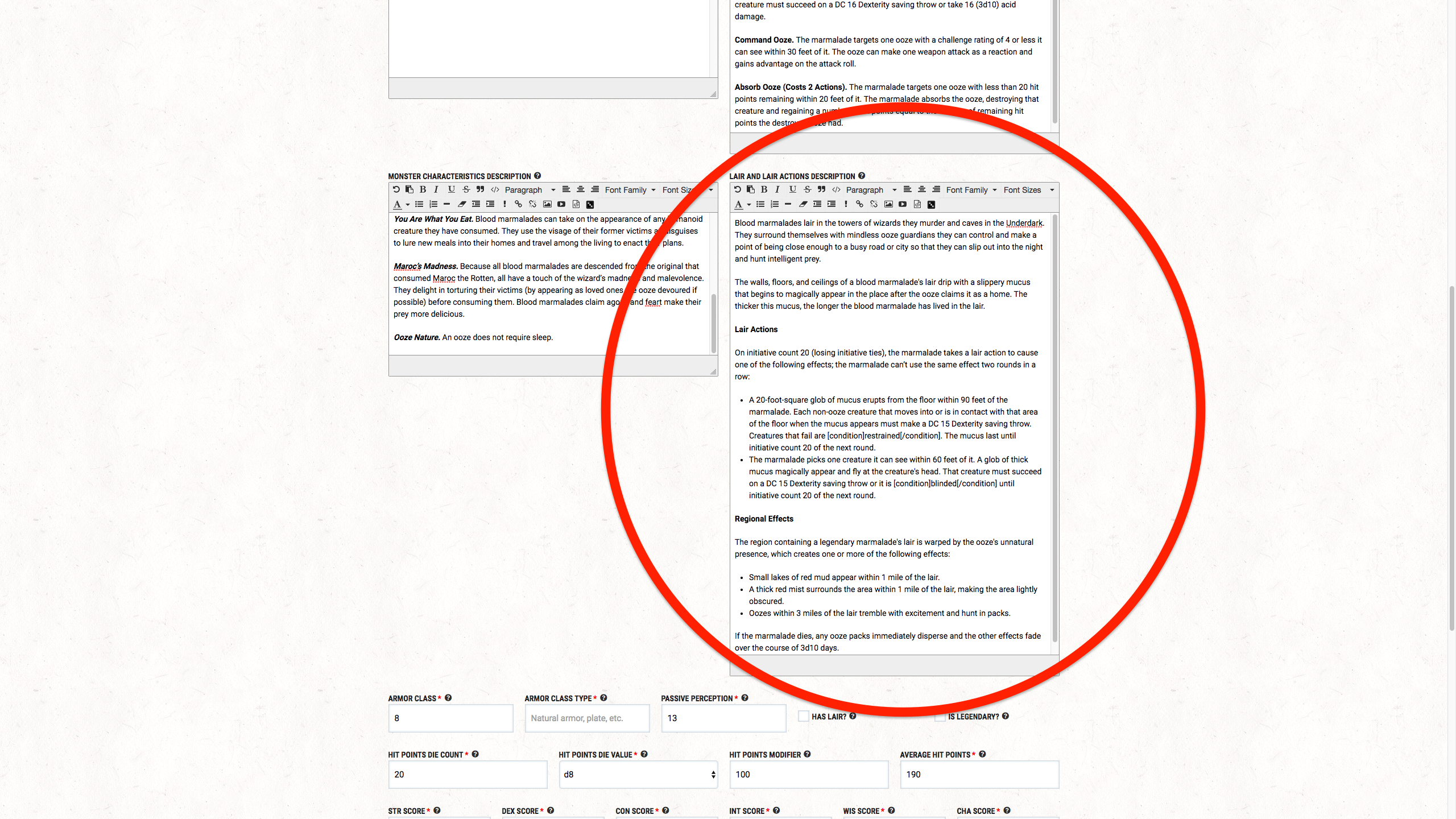
Step 19. Tags and Images (D&D Beyond Only)
Add any tags your monster has like devil, orc, or shapechanger. D&D Beyond also lets you add an image for your creature. After this step, create your creature by clicking CREATE MONSTER.
Uploading an image from your computer is easy. If you're using this monster privately, you can use any art you want. But if you want to share this art with the community, consider using art already on D&D Beyond, or commissioning new art from a friend, rather than using copyrighted art. I had art for my monster created by Jackie Allebach.

Step 20. Additional Information (D&D Beyond Only)
Once your monster is created, you can add languages, senses, skills, and movement to your monster in D&D Beyond.
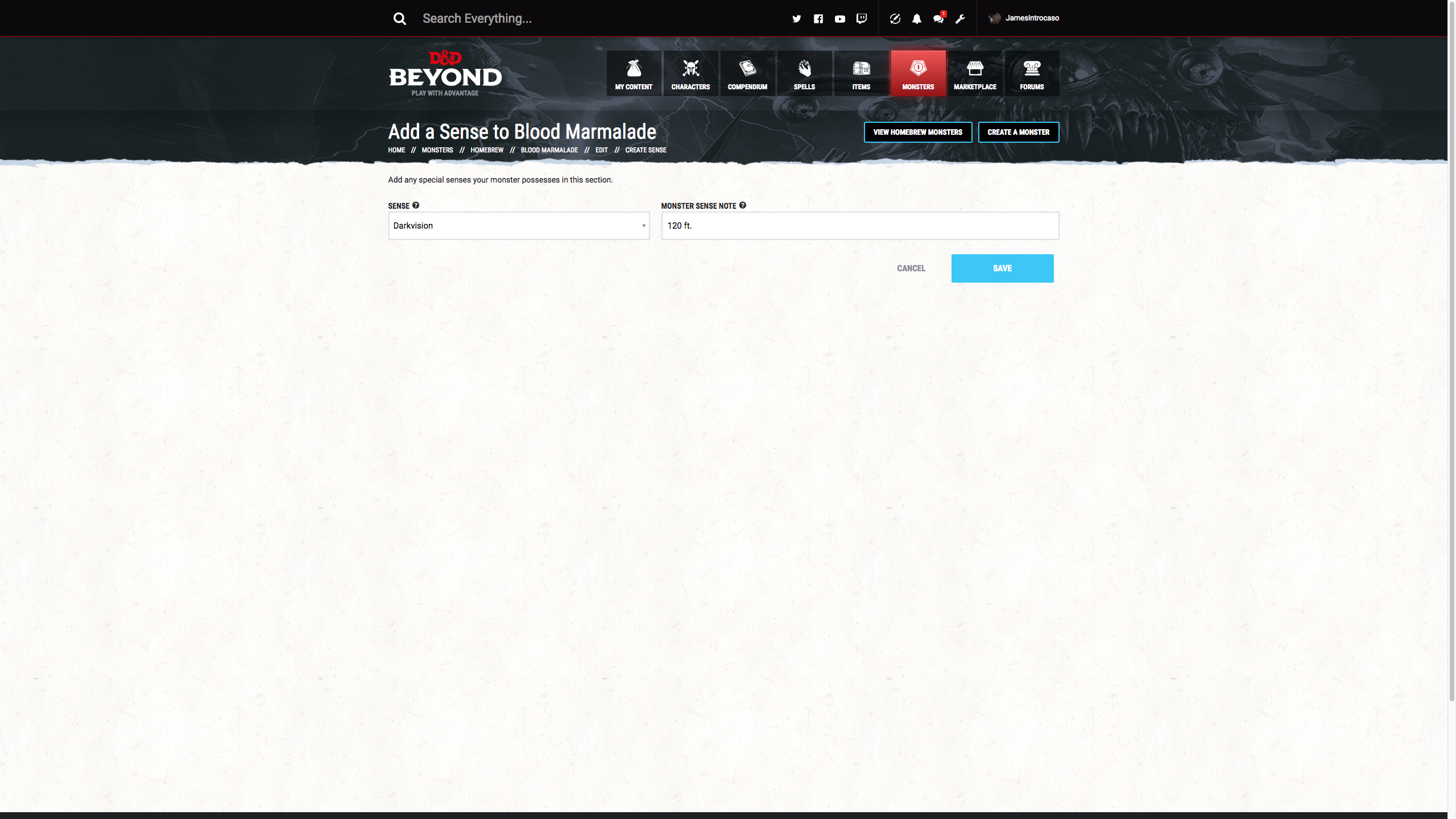
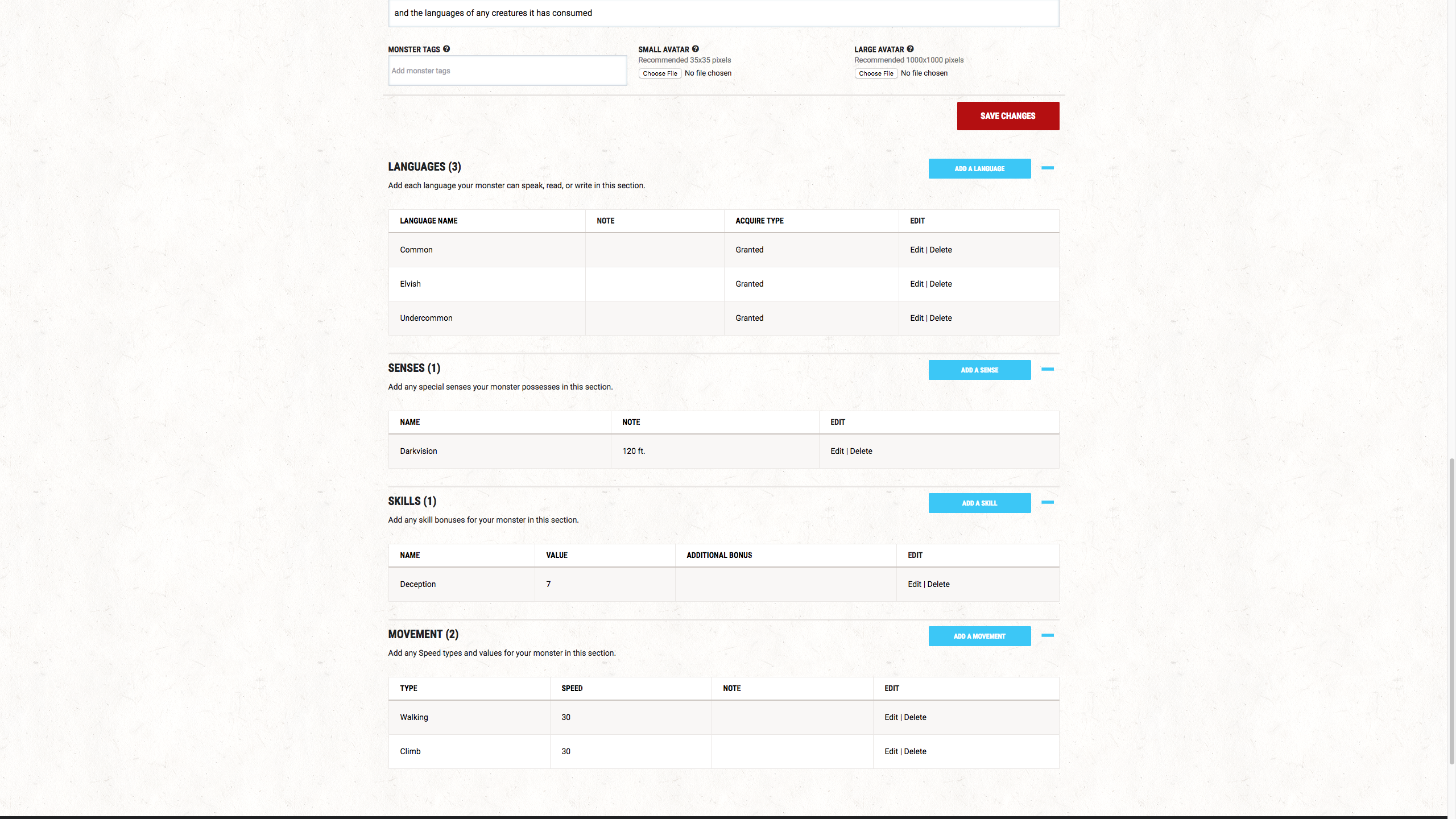
Step 21. Edit and Playtest
Now that you’ve created your monster, give it a once over. Read it out loud and edit. Even the most experienced designers need to edit their work. Then send your work to a friend to make comments. A second pair of eyes helps you understand if the design intent of your creature is coming through.
If you have the opportunity to playtest your new creature, take it! Nothing is a better test of your design work than actually seeing it in action. Plus it’s a great excuse to get friends together for a game of D&D! Change anything you think needs it after playtesting.
Step 22. Make Your Work Public
It’s time to make your work public! That means sharing the monster with your group, posting it to a blog, putting it up for sale on the DMs Guild, or right here on D&D Beyond. To do this in D&D Beyond go to the MY CREATIONS page, select your monster, and click MAKE PUBLIC. A message then appears asking if you’ve read the Public Homebrew Content Rules & Guidelines and explaining the moderation process for public content.
If you’re ready to submit your monster, click SUBMIT and you’ll get a moderation notice from the D&D Beyond team once your item is accepted or rejected. Make sure you actually read the guidelines. Most rejections happen because the creator hasn't followed one of the very simple guidelines, or because they're attempting to publish work they don't own or didn't create themselves. Please note that it is completely fine to keep your creation private if you intend to to only use it in your own game and do not wish to share it.
Lucky for me the blood marmalade was accepted. You can find the final version here.
Go Make Stuff!
There you have it! A step-by-step process for creating a D&D monster. I can’t wait to see what people submit to the great D&D Beyond. If your design gets posted, please share a link with me on Twitter at @JamesIntrocaso. Next time in the Design Workshop, I’ll show you how to make a new race!
James Introcaso blogs at World Builder Blog, podcasts at Don’t Split the Podcast Network, and designs games for Wizards of the Coast, Roll20, Kobold Press, Roleplaying Tips, and more.








-
View User Profile
-
Send Message
Posted Mar 27, 2018Thank you for the awesome article i was trying to make my own monster but I was failing miserably. This article will help!
-
View User Profile
-
Send Message
Posted Mar 27, 2018This is such an awesome monster! (Mind if I steal it?)
-
View User Profile
-
Send Message
Posted Mar 28, 2018Very nice! Was the link you gave to the blood marmalade the final version of the monster, though? Because it is missing the awesome image shown here, and there is a typo I don't see in the article page. (Search for "feart".) But again, I love these articles and examples, so thanks! Please keep them coming!
-
View User Profile
-
Send Message
Posted Mar 30, 2018Awesome idea! I was a bit confused on how to make one until I read this
-
View User Profile
-
Send Message
Posted Apr 8, 2018Thanks for the great work
-
View User Profile
-
Send Message
Posted Feb 23, 2019please make a design workshop: encounter of the week
-
View User Profile
-
Send Message
Posted Apr 2, 2019How do you apply a CR to an NPC you created using a character sheet?
-
View User Profile
-
Send Message
Posted Sep 27, 2019This is super helpful! Thank you for the article
-
View User Profile
-
Send Message
Posted Apr 18, 2020Is there a way to use my homebrew monsters in the encounter editor if I keep the monster private? Or do I have to publish it? I cannot figure out how to view my creations in it. Thanks
-
View User Profile
-
Send Message
Posted Jul 13, 2020I'm also very curious about this. Example: I made a level 11 Warlock of the Fiend, half-elf, full class and race features. I asked about it on the Warlock page, and have decided on CR 6 (he had a few magic items, too). But it would be really nice to be able to calculate it on my own without asking every time. Oh, and I don't have any sourcebooks yet.
Thank you for the great article!
-
View User Profile
-
Send Message
Posted Jul 15, 2020For low levels I just use half the character sheet's total level, plus one as the CR for a full sheet NPC. For higher levels, I use 2/3rds the level of the character (A basic lv 18 wizard NPC is a CR 12, for example) It seems to pretty well match the 'people' type npc 'monsters' that are listed. For crazy powerful boss types, I'd just refer to existing crazy type bosses, like Acererak, etc.
-
View User Profile
-
Send Message
Posted Dec 15, 2021How does someone make custom creature subtypes? I'm trying to make Deep One Scions based on Sandy Petersen's Cthulhu Mythos 5e, but the system doesn't allow me to use a creature type/subtype like the book says:
humanoid (deep one)
I don't understand why this feature (along with quite a few others in homebrew DnD Beyond) doesn't have an open-ended input option (an option to put in custom/non-standard options). Doesn't it defeat the purpose of homebrewing if we can't properly homebrew?
Edit: I tried using the tag system instead and it has the same issue of being locked in a set of options I can't change or add additional options to. Very frustrating.
-
View User Profile
-
Send Message
Posted Jul 25, 2023If my creature doesn't have reactions/bonus actions how do I get the field to stop showing up on the "view details" page so I can print without a bunch of extraneous, blank boxes?
-
View User Profile
-
Send Message
Posted Jul 26, 2023Not sure what you mean by the "view details" page. If you see boxes that you can type in, you are still editing the creature. You can Save Changes and then either select your creature's name in B > HOMEBREW > CREATIONS > [your creature name] (before > EDIT) in the upper left of the screen, or go to Collections, My Homebrew Creations, and click on the creature there. Fields like "bonus actions" that were empty while you were editing shouldn't show up. (And don't for me.) If you still see them, maybe edit again and make sure to delete any spaces you find within them and resave.
-
View User Profile
-
Send Message
Posted Jul 26, 2023Deleting everything in these fields seems to have done the trick; though I could swear I'd tried that before to no avail. Thanks.
-
View User Profile
-
Send Message
Posted Mar 5, 2024Whant a worthless, pathetic article. Its worthless and pathetic, cuz it shills for the broken math and rules of dnd5. An analysis of the monsters in dnd5 done by "Blog of Holding" shows that authors themselves dont stick to their own guidelines. The "DMG" table for monster creation shows u how the monsters grow in power per lvl, including dmg dealt, prof. bonus, ability dc and ac and u r supposed to match this. U r also prompted to find an average of their offensive and defensive capabilities for glass cannons and tanks. MEANWHILE the official, published, 1st party sources routinely go above armor of 19, which is ought to be the cap for bounded accuracy, reflecting the best a player can get. Max hp keeps rising, monsterss chance to hit goes up and theres no distinction between heavy hitters that r easy to kill vs dmg sponges.